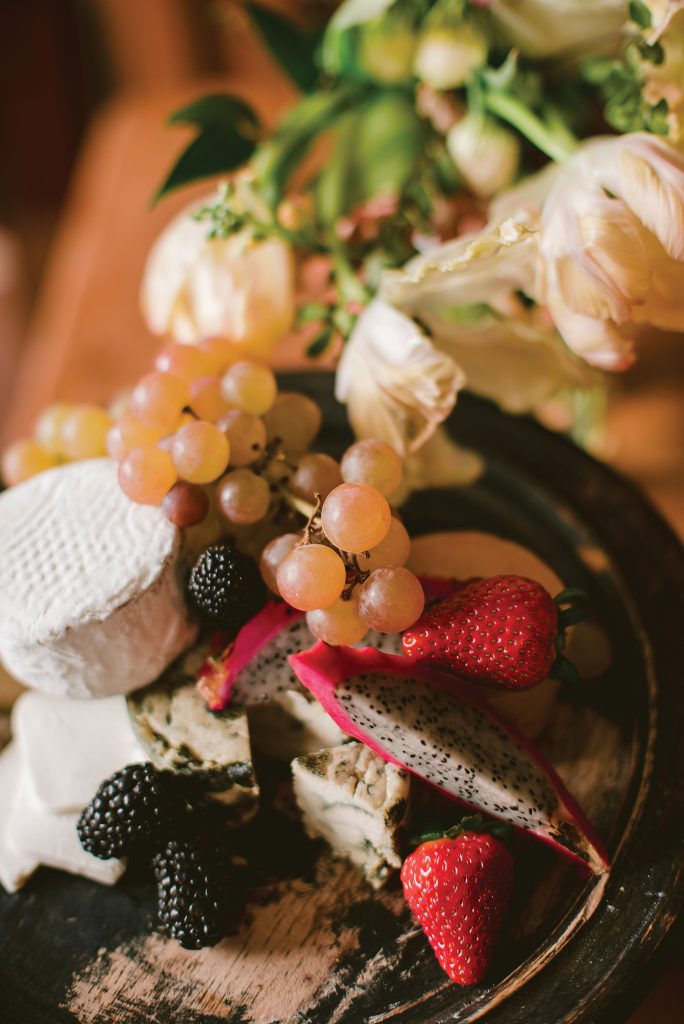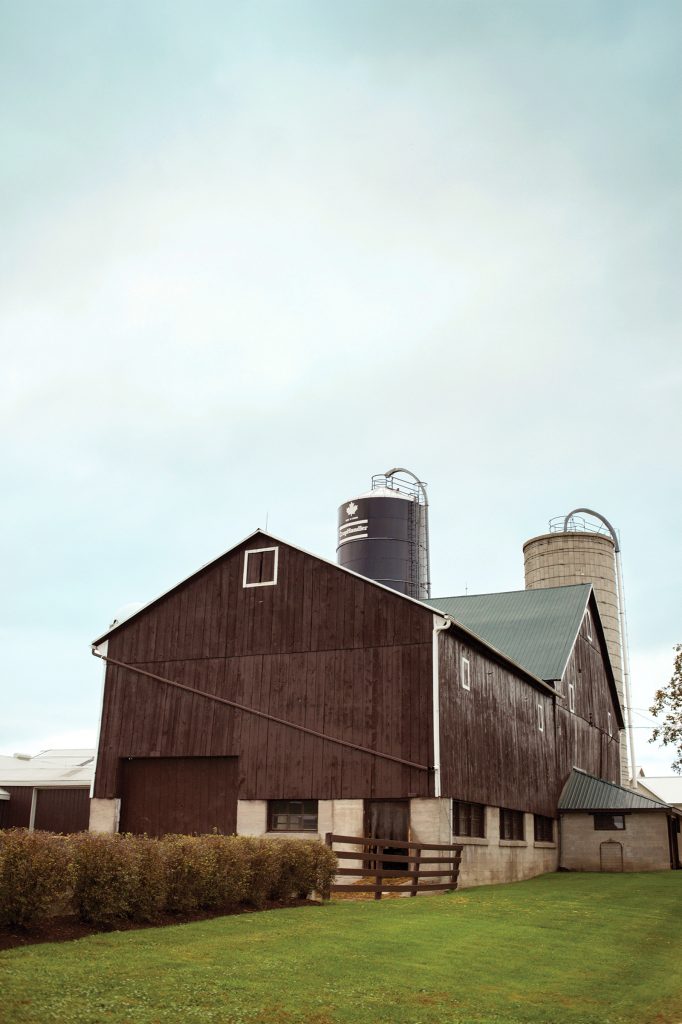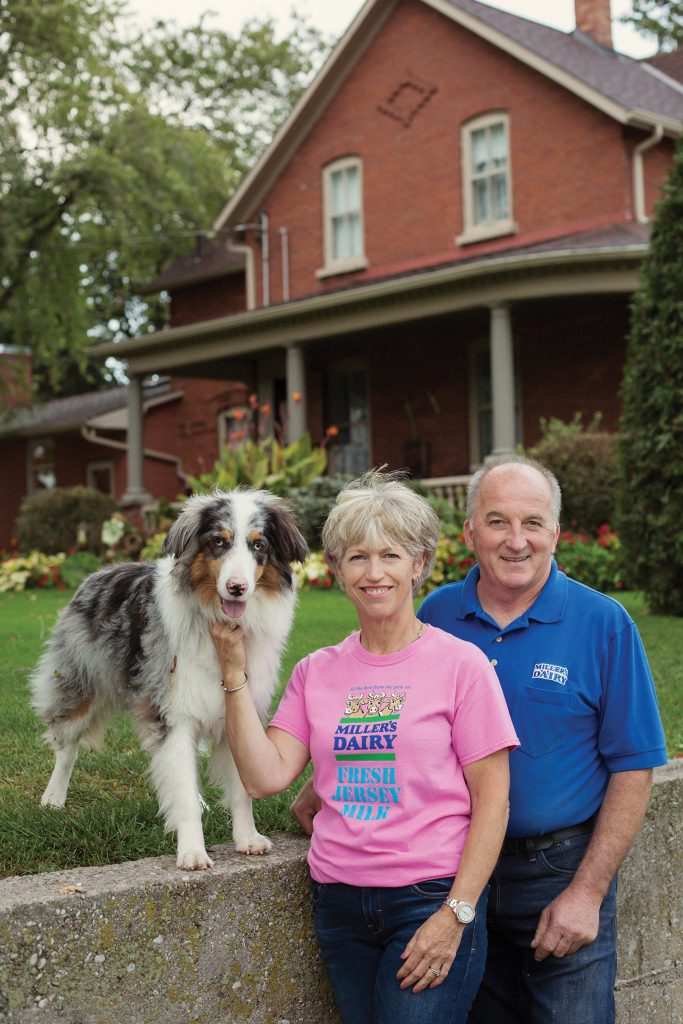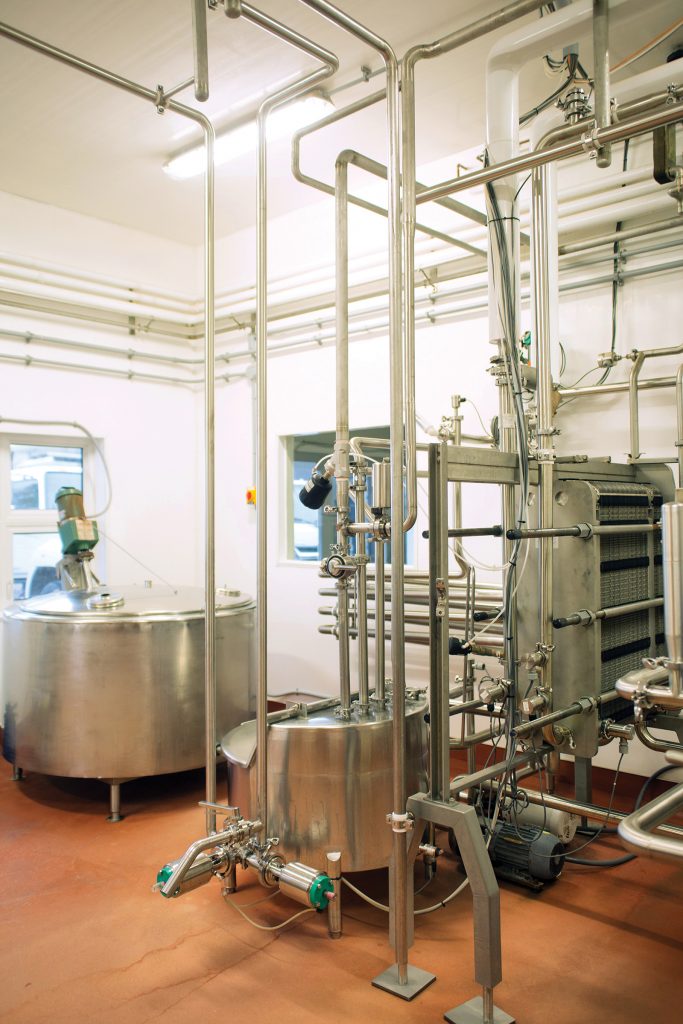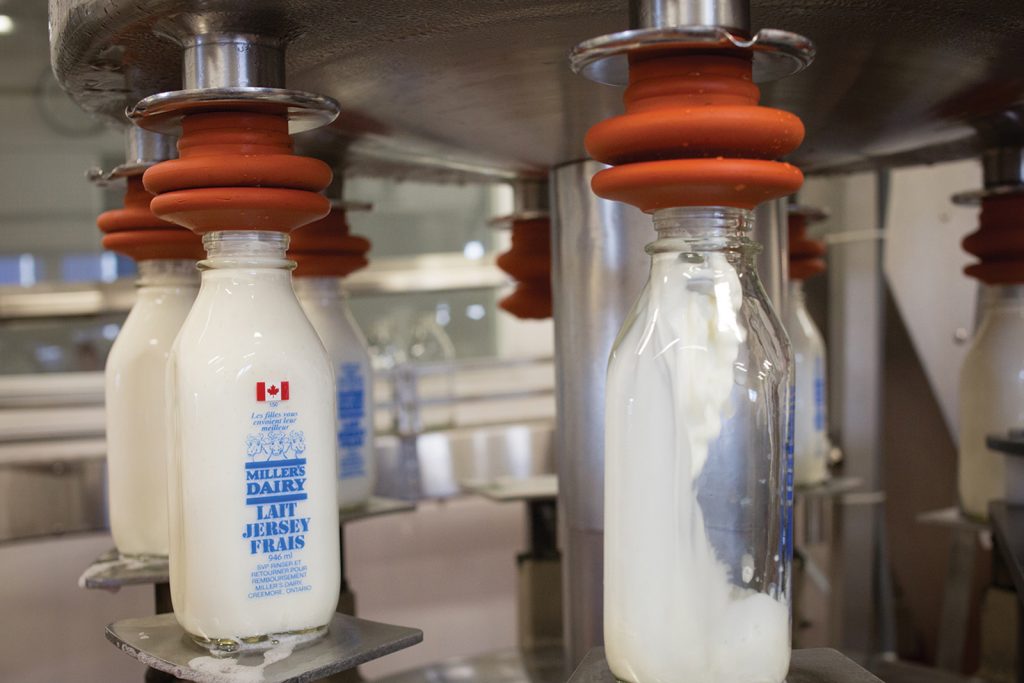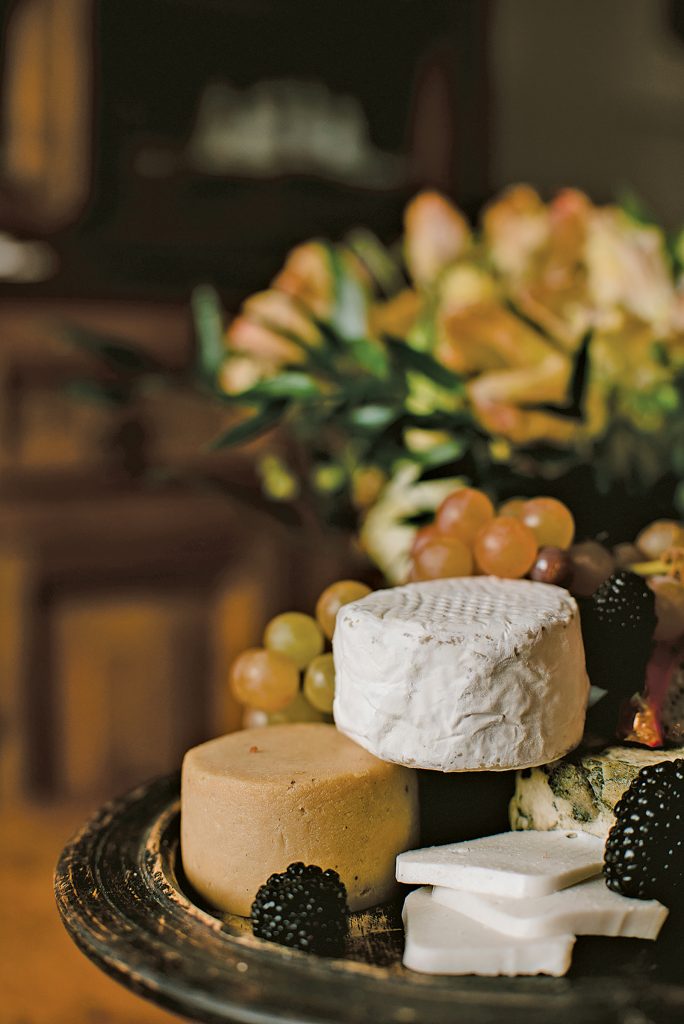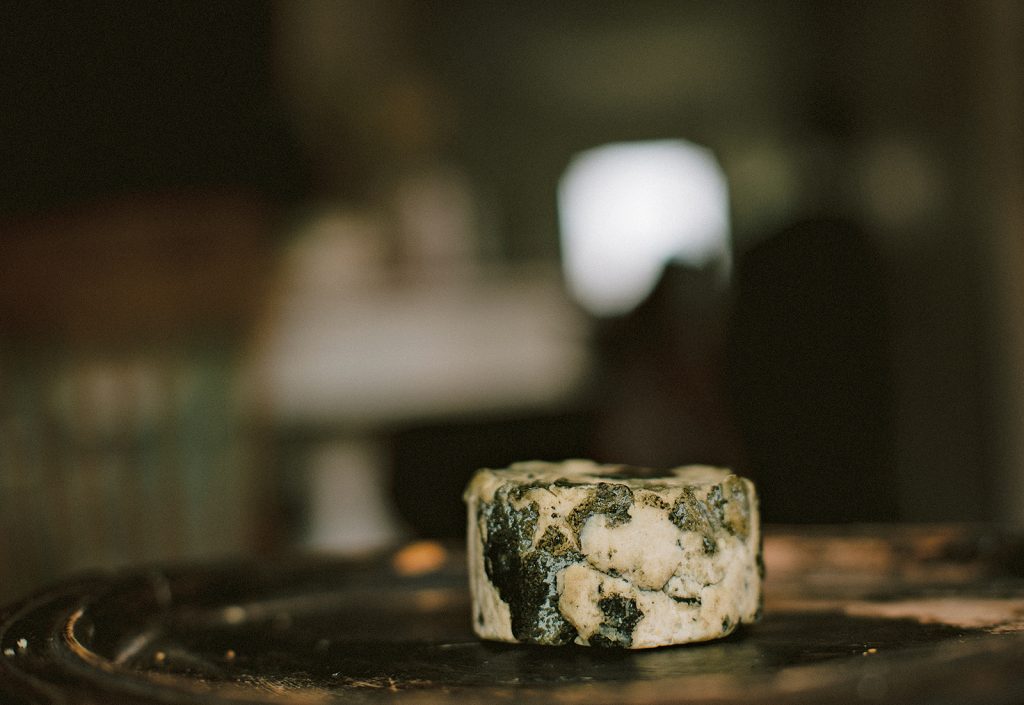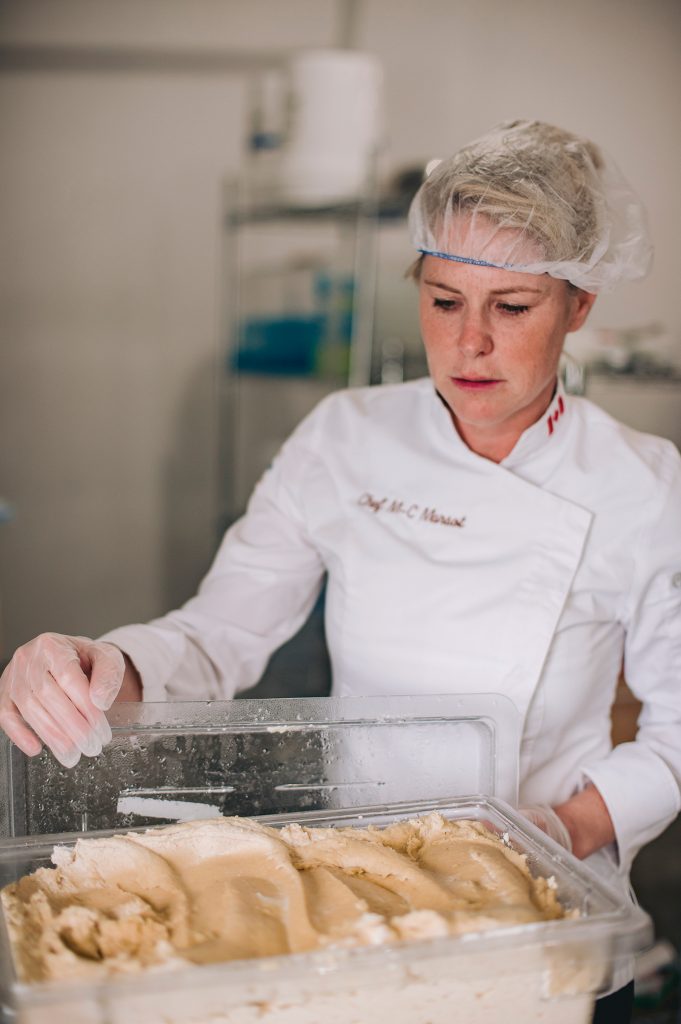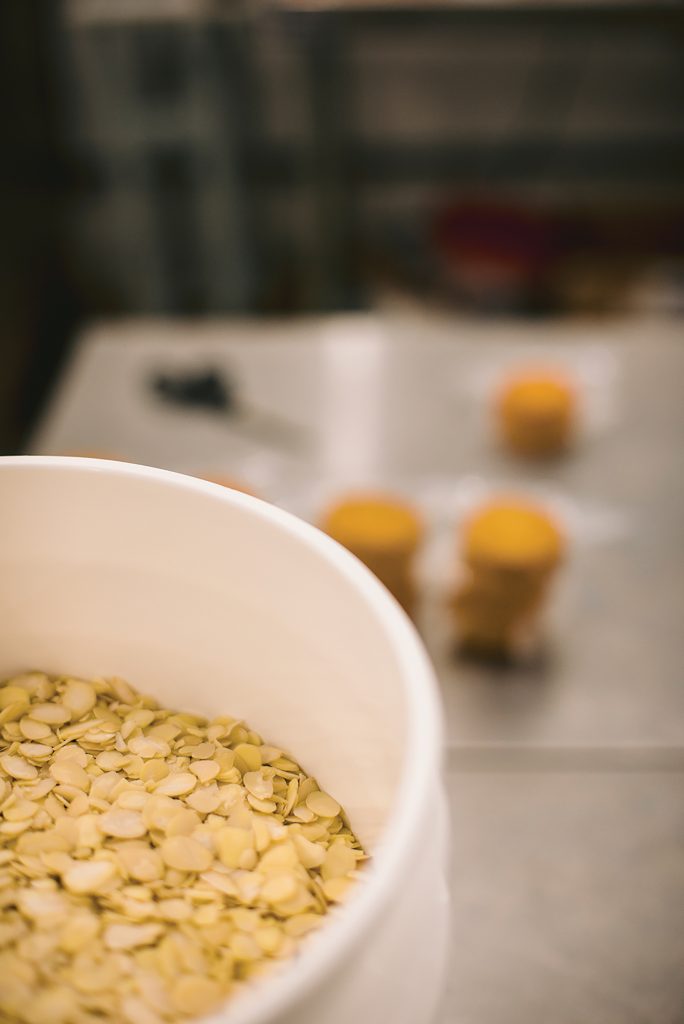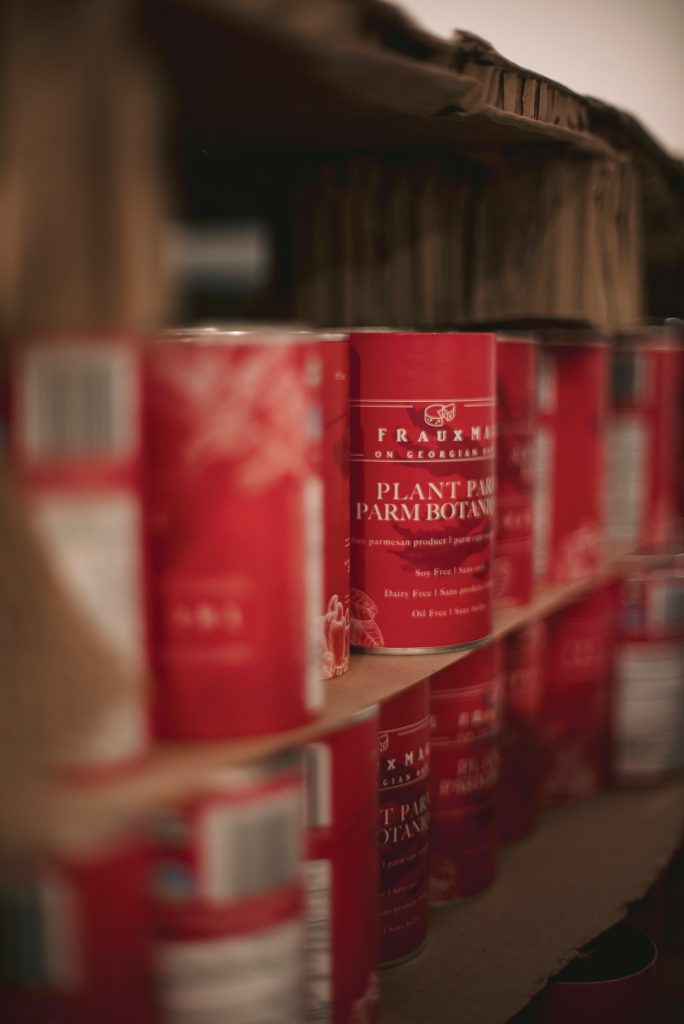Miller’s Dairy and The Frauxmagerie are proving that local ingenuity can be delicious
by Emily Worts
Today’s food landscape is increasingly about honouring old traditions and finding new ways to meet unique demands. Back-to-the-land food movements mean a renaissance for local food and also a return to tradition.
Fourth-generation dairy farmer John Miller is transforming his Creemore century farm and increasing its offerings to meet demand for local milk and related products like ice cream. Utilizing the unique qualities in heirloom plants and various breeds of animals, like those found in true Jersey milk, means increased choice along with healthier and tastier alternatives.
Local food production is also evolving to meet new challenges, like the increased popularity of plant-based, vegan and lactose-free diets. Just up the Georgian Bay shore, food entrepreneurs at The Frauxmagerie in Meaford are carving out a niche market in dairy-free fine cheese alternatives. This young company sees the potential and the reward in the increased demand for plant-based foods, ensuring there is room at the deli counter for their cashew-based, non-dairy delicacies.
These are just two examples of local entrepreneurs who are passionate about food and finding innovative ways to create high-quality choices everyone can enjoy.
Cream of the Crop
I follow John Miller through a shallow trough of water, sterilizing the bottom of my shoes before stepping into the gleaming “Raw Room” of Miller’s Dairy. The Raw Room, part of the dairy’s processing plant, was built seven years ago when the dairy opened for business. Everything looks state-of-the-art, but on closer inspection I see the highly polished patina on much of the chrome and steel machinery. Some of the equipment is brand new, but much of it – including the cream separator, the homogenizer, the filler and the bottle washer – dates back to the 1950s. “We bought it used and older because that’s where the quality is,” says Miller.
One of Miller’s latest acquisitions, an antique ice cream maker, is no exception. And like all good antiques, it has a story.
John Miller’s maternal grandfather was one of five brothers of the eponymous Bisset Brothers ice cream out of Goderich, Ontario. “It was big business in the 1960s,” notes Miller. But the successful ice cream operation closed for good in 1969, and from then on Miller has had the ambition to return to his roots and produce premium ice cream.
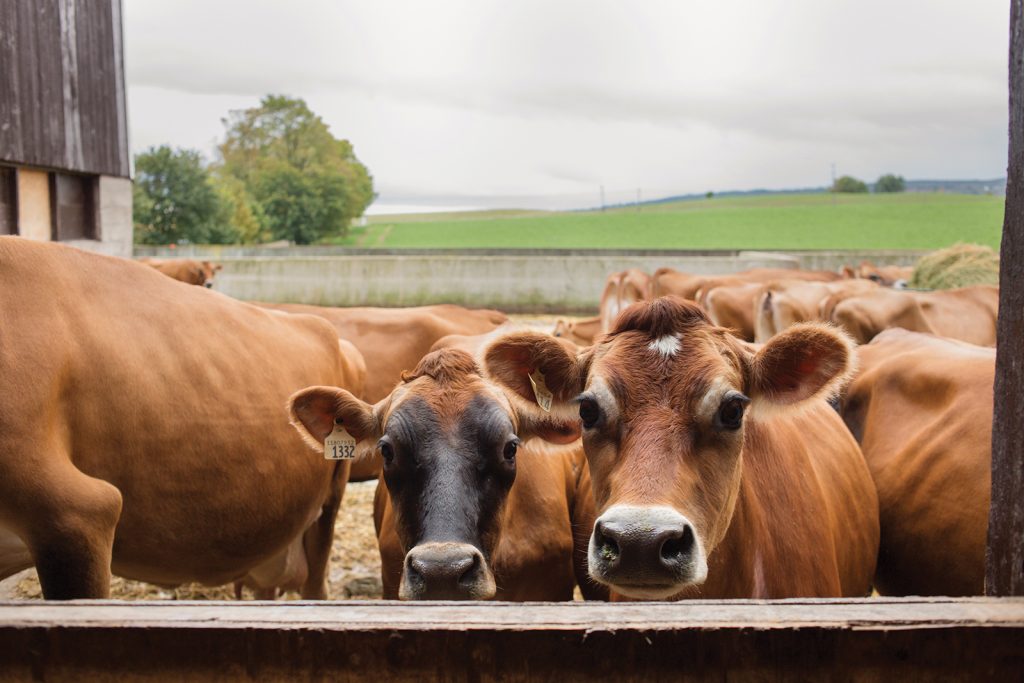
“Ice cream has to have 10% fat content to be called ice cream,” says Miller. “Ours will be 15% and will be in league with Haagen Dazs and Ben & Jerry’s.”
The family farm in Goderich had changed hands, but Miller had a suspicion the 1,500-pound ice cream machine was still there. His instincts were right, and the new owners offered the machine to Miller so he could actualize his dairy dream.
Miller’s Dairy processes 14,000 litres of fresh Jersey milk every week and as part of that process they ‘skim off’ litres and litres of cream. It’s a continual conundrum for any successful dairy: what to do with all that extra cream? “The Girls,” as the Millers’ Jersey herd is known, produce 5.4 per cent butterfat milk. The average fat content of the milk they sell is 2.8 per cent. “We have a lot of surplus cream, which we had been selling at cost to a local creamery,” says Miller.
He recognizes the cream is a valuable byproduct with great potential. The ice cream maker was installed to help add value to that cream. “The natural next step was to utilize the surplus cream into a product that could enhance our business and also create a line of products that is much less perishable than our bottles of milk,” he explains.
The ice cream maker hadn’t seen action in almost 50 years, but if Miller’s Dairy was going to make ice cream, John Miller wanted it done with his grandfather’s machine. The machine, built in the ’40s, is a relic; the only person he could find to bring it back to life was in Louisiana. It was shipped south last winter, with the goal of being refurbished in time for Miller’s Dairy Day in July, which attracts around 6,000 visitors every year, and the launch of the dairy’s first premium ice cream flavours.
Miller’s Dairy is located just outside of Creemore on Jalon Farms and has been home to a Jersey herd for generations (Miller is the fourth John Miller to run the farm). But it wasn’t until seven years ago that he and his wife Marie (who was also raised on a dairy farm near Cookstown) saw the true value in what their farm was producing. Until 2012 the milk from Jalon Farms’ 120 head of Jersey cattle was simply mixed in with all the other milk produced in the area and sold to the milk board.
“We had an opportunity to create a distinctive product and differentiate ourselves in the market,” says Miller. “Prior to this, the unique Jersey qualities were lost.”
Jersey milk not only has a higher content of protein, fats and calcium; it maintains its white colour and, some would argue, it tastes better, too. Especially when stored in glass bottles. “There is no plastic or cardboard flavour sneaking into your milk and it’s also better for the environment,” says Miller of his unique retro glass bottle that has become symbolic of his dairy.
The Miller’s Dairy line of products has steadily increased since 2012. The business began with 2% and chocolate milk and quickly added 1% and skim, followed by 3.25%, half-and-half and 35%. Eggnog is sold seasonally, and in the past year they began producing strawberry and coffee milk on a weekly basis.
“We’ve built a brand and you can’t build a brand without maintaining quality,” says Miller. “Our eggnog is a prime example. A lot of time was spent on the recipe because we knew it had to be good. Our customers expected it. It’s what we always have in mind and we get rewarded.”
Miller’s Dairy went from zero eggnog sales in its first season to matching its chocolate milk sales in the first week.
“It sure caught me off guard. It was a crazy eye opener,” says Miller of the eggnog’s success. “We ordered 14,000 bottles and we were scrambling for more bottles the last week.”
Miller is hoping the business will face the same dilemma with its new ice cream, noting he has ordered 50,000 containers to start and will continue filling the new 5,000-cubic-foot freezer with the new ice cream flavours as soon as possible.
The initial 11 flavours include the standards like vanilla, chocolate and strawberry, which were introduced at last year’s Dairy day. The rest of the flavours are a surprise, but Miller’s Dairy is all about keeping it local and will use names and flavours that honour the local landscape. Look for names like Cashtown Crunch, Creemore Cupcake, Bear Alley Berries, Jersey Mint, Moo Mountain Coffee, Rocky Mad River, Ten Hill Slide and Topless at Wasaga.
“Ice cream has to have 10% fat content to be called ice cream,” says Miller. “Ours will be 15% and will be in league with Haagen Dazs and Ben & Jerry’s.”
Miller’s goal is to deliver high-quality ice cream that is as natural as possible, at an affordable price. He says all ingredients listed on the back of the ice cream container will be easy to pronounce – unlike chemical ingredients that are usually multi-syllabic tongue-twisters. “We’re using an egg-based stabilizer, which gets rid of all the difficult words,” says Miller with a smile.
And like the milk that came before it, the locally made, premium ice cream will be accessible.
“We feel everyone should have the opportunity to buy a good quality product,” says Miller, noting the dairy isn’t always about making money. “It’s about making a living and enjoying what we do.”
It’s also about honouring the past and creating a future. From John Miller’s pioneering paternal great-grandparents and maternal ice cream-making grandparents to Marie’s dairy farm upbringing and continuing with their son Shawn, who is now working at the dairy, it seems that milk courses through the family’s veins.
This way of life, with its early mornings and demanding tasks, isn’t for everyone, but for Miller it is everything he has ever dreamed of. He realized his ambition to become a dairy farmer and now he’s taking the next step. Since his boyhood summers spent on the shores of Lake Huron, eating his grandfather’s ice cream, he has wanted to return to his ice cream-making roots. Luckily for all of us who enjoy nothing more than the simple pleasure of a cool cone on a hot day, dreams do come true.
Say Cheese!
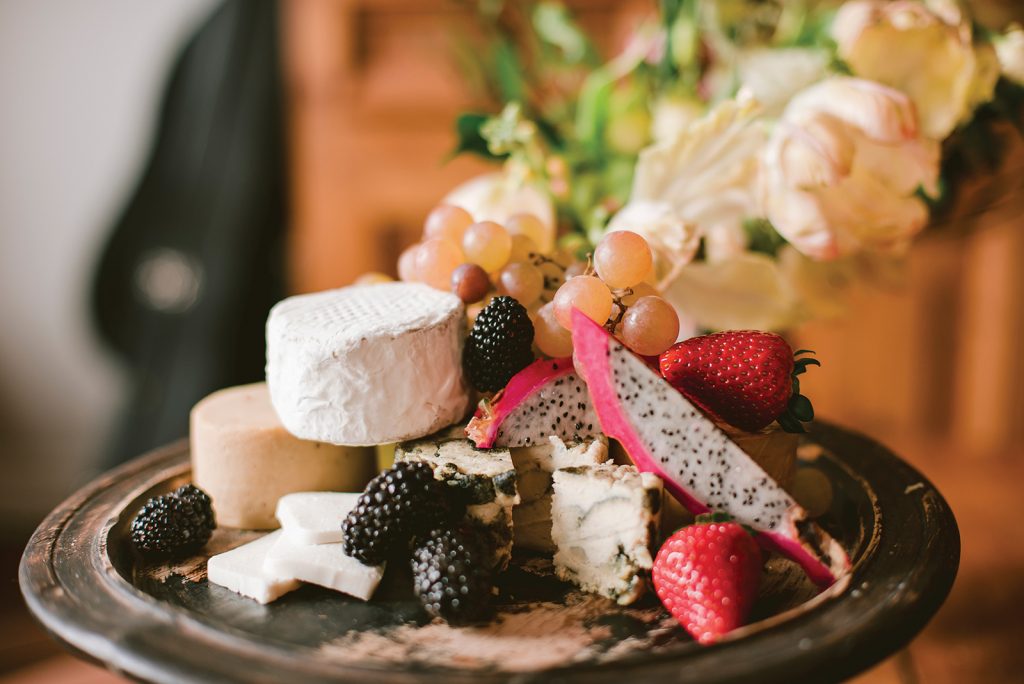
In a food climate of constant questioning, whether it be ethical, eco-friendly, or ailments related to what we put into our bodies, the increasing demand for dairy-free products has never been greater.
Meaford is not known for its cheesemaking. In fact, according to the Cheese Lover’s Guide to Ontario, artisanal cheese makers are non-existent in Southern Georgian Bay.
Yet, when I cut through the gauzy, soft rind of the Frauxmagerie’s Botanic Camembert, made in downtown Meaford, and spread the mildly nutty goodness on my baguette, I am transported to the south of France. Surprisingly, this Camembert was made not far from the shores of Georgian Bay and within 50 kilometres of my home in Creemore.
I’m in for another surprise when I read the ingredients listed on the pale green box it comes packaged in; they’re far from conventional and mark a huge departure from this cheese’s French counterparts.
Botanic Camembert is made from cashews (organic and fair trade from Africa), nutritional yeast, vegan probiotics (made in Toronto using Jerusalem artichoke), bacterial cultures, filtered water and salt. The last surprise is what’s not on that list: this Camembert is made without a drop of dairy.
It’s one of eight cheeses or ‘frauxmages’ produced by The Frauxmagerie, a growing Meaford business committed to creating 100 per cent dairy- and gluten-free cheese alternatives. The Frauxmagerie delivers the authentic taste and textures ardent cheese lovers crave, without the dairy.
Marie-Catherine Marsot, originally from the small town of Rimouski, Quebec, is the founder and head cheese maker of The Frauxmagerie. She came up with the idea while teaching a plant-based food course at Liaison College, a culinary school in Barrie. The fact that there is such a course attests to the growing demand for plant-based, vegan and lactose-free foods. But any commercial vegan cheeses Marsot brought in for her class to sample just didn’t cut it with her students. The texture was always more like cream cheese and her students wanted something true-to-taste. Marsot began experimenting, and her students began buying up her products.
Marsot saw a need and so did the judges of Meaford’s Dragons’ Den, who awarded her $4,000 in November, 2017. Using her winnings, Marsot converted half of her home into a food-safe facility, began experimenting with bacterial cultures and in December 2017, the Frauxmagerie was born.
The business, which won Meaford’s Most Improved Business Award in March, has moved on from its original digs and is now home to eight varieties of cheese, which are divided into two categories: Botanic Fresh, which can be melted, and Botanic aged, which are aged from 12 days to two weeks. The Botanic Fresh line includes Plant Parm (a grated parmesan-style frauxmage), Mauxarella (a faux mozzarella), Frauxmage Curds, and Greek Frauxmage (a feta-style frauxmage). These products are not aged and include additional ingredients like almond, coconut oil, apple cider vinegar and various herbs. The four aged frauxmages each use different bacterial cultures and different processes, resulting in Botanic Swizz, Botanic Boka, Botanic True Blue and the Botanic Camembert.
Merlot Duncan-Cole, daughter of humorous individuals who have a love of wine, recognizes the irony of her name and her new position as director of marketing for a ‘cheese’ company.
“Wine and cheese, of course they go together,” she laughs.
Duncan-Cole was hired by The Frauxmagerie in the spring of 2018, to help meet the increasing demand for the upstart’s growing line of products.
“We are innovating as we go,” says Duncan-Cole.
The Frauxmagerie is half kitchen and half science lab. Since dairy-free, plant-based and aged cheeses represent a relatively young field, the staff at the Frauxmagerie is experimenting all the time. Dressed in hairnets, chef’s jackets and armed with gloves, the team of five is always discovering.
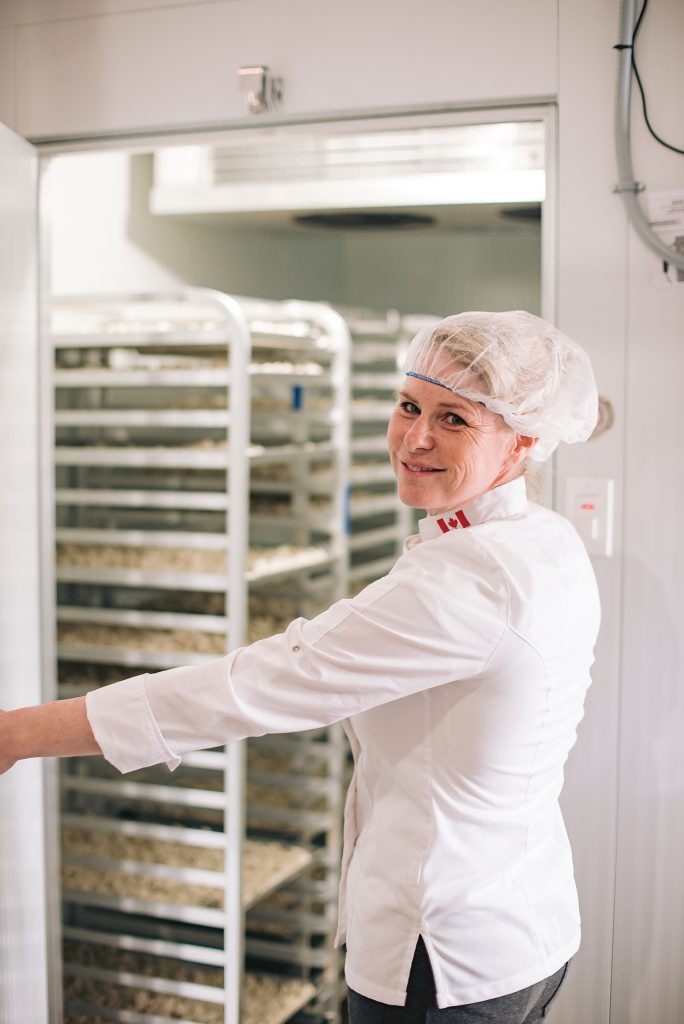
“The Camembert is a really picky cheese,” says Duncan-Cole. “It needs its own room.”
To accommodate the Camembert and the growing family of products, The Frauxmagerie has had to double its production space from 2,000 to 4,000 square feet since its inception in 2017. The new space is large but minimalist. In addition to two large walk-in refrigerators, there are smaller fridges designated to each cheese and a super-sized 23-quart commercial blender, the Robot Coupe. True to its name, the machine resembles a robot, standing tall, ready to blend ingredients together, forming a smooth cashew cream that is left to ferment and firm up for 24 hours. The frauxmage is then handcrafted into wheels with each variety placed in its own fridge. The aged frauxmages are flipped daily, to make sure they grow and develop a consistent rind.
“We make ourselves different by aging our products,” says Duncan-Cole. “If you put our Camembert beside a traditional Camembert, we are very close to the dairy alternative. It’s as authentic as possible.”
Time and the bacterial cultures are what differentiate the frauxmages, giving them an authentic flavour, texture and aroma.
Increasingly, naturopaths, doctors and the people they serve are seeing connections between physical and hormonal ailments and the food they eat.
“The beautiful thing about dairy-free cheeses, especially the really good ones, is that they really do taste like cheese,” says Tara Gignac, a naturopathic doctor at Stonetree Clinic in Collingwood. “You get the cheese piece without whatever it is that’s bothering you.”
Gignac is quick to point out that there are many different reasons to choose a dairy-free diet, but notes that naturopaths are not about pushing a dairy-free diet for everyone.
People who do react to dairy – and again, that is not everyone – react for a variety of reasons. People may have a true intolerance, meaning they don’t have the enzyme to break down the sugars in the milk. Others may have an intolerance to the milk protein, leading to inflammation, skin problems, joint issues and tummy troubles. Others avoid dairy because it can exacerbate existing hormone imbalances (dairy intrinsically has hormones in it, some more than others depending on how it is farmed), leading to problems around menstruation and hormonal acne, for example.
In a food climate of constant questioning, whether it be ethical, eco-friendly, or ailments related to what we put into our bodies, the increasing demand for dairy-free products has never been greater. Today, alternative products line the shelves of not just health food stores but conventional grocery stores as well. At the Thornbury Foodland’s deli counter, displayed alongside other artisanal cheeses, is a selection from The Frauxmagerie.
There is shredded Mauxarella for your pizza, Frauxmage curds for your poutine, Greek Frauxmage to crumble in your salad, True Blue Botanic to serve with sliced apple, and of course the Botanic Camembert, which tastes delicious on its own or spread over a fresh crusty baguette. In addition to other area Foodland stores, the following also carry Frauxmagerie products: Thornbury Bakery, Creemore 100 Mile Store, Georgian Health Foods, Orchard Health Foods, Many Hands of Meaford.
Thanks to The Frauxmagerie, those who can’t live with cheese but really can’t live without it can now enjoy fine, handcrafted cheese alternatives. They are raising the bar when it comes to plant-based, dairy-free cheese and they are doing it in our own backyard, along the shores of Georgian Bay.
Although Miller’s Dairy and The Frauxmagerie may appear to be at opposite ends of the food spectrum, they have a lot in common. They are both innovators, creating distinctive food products using a limited number of high-quality ingredients while differentiating themselves in the local food market by honouring the process and the taste. ❧







